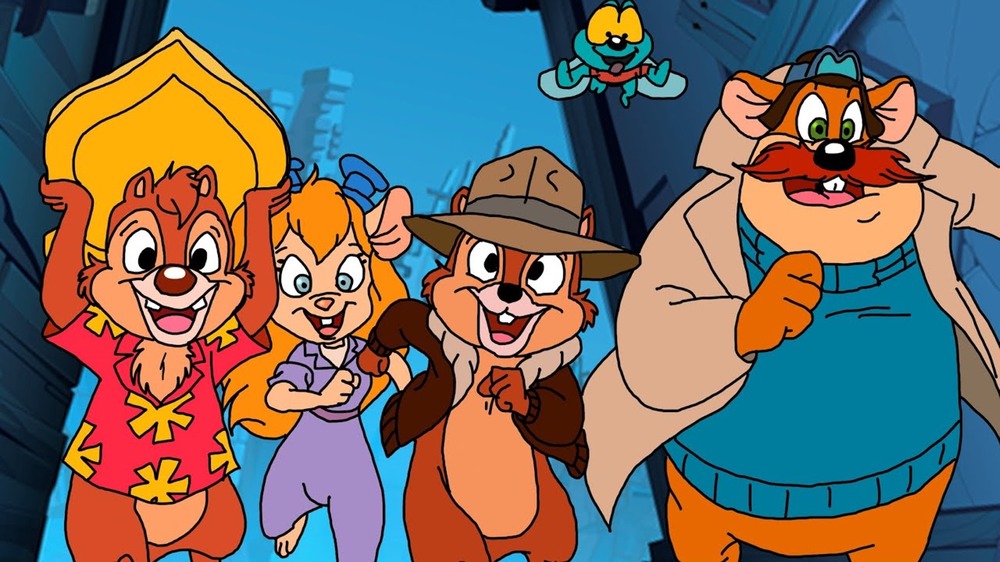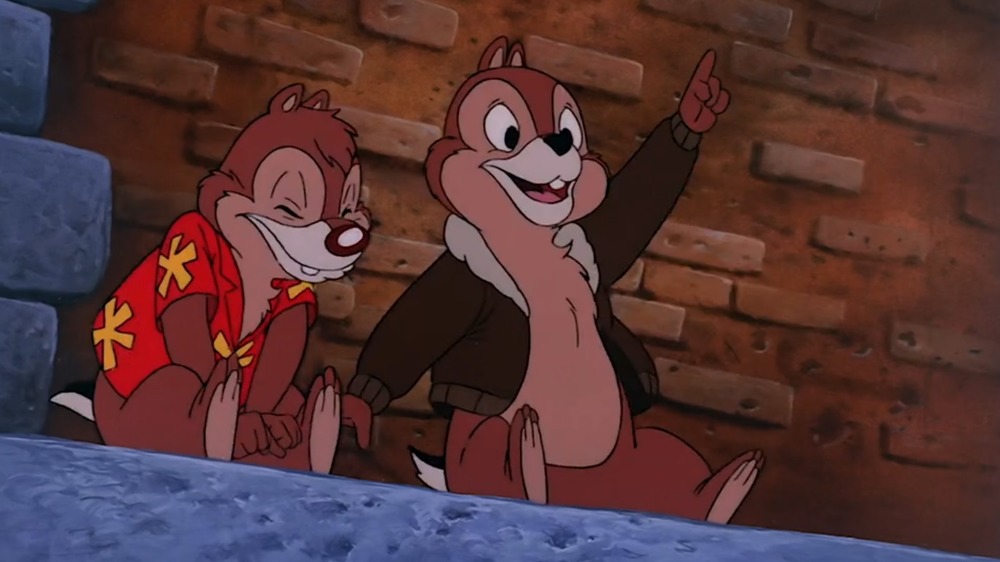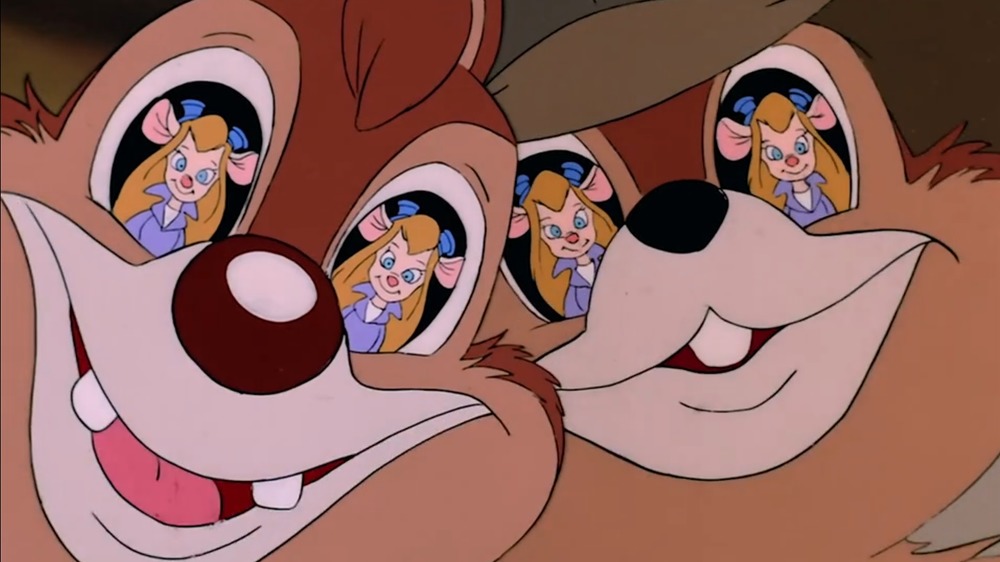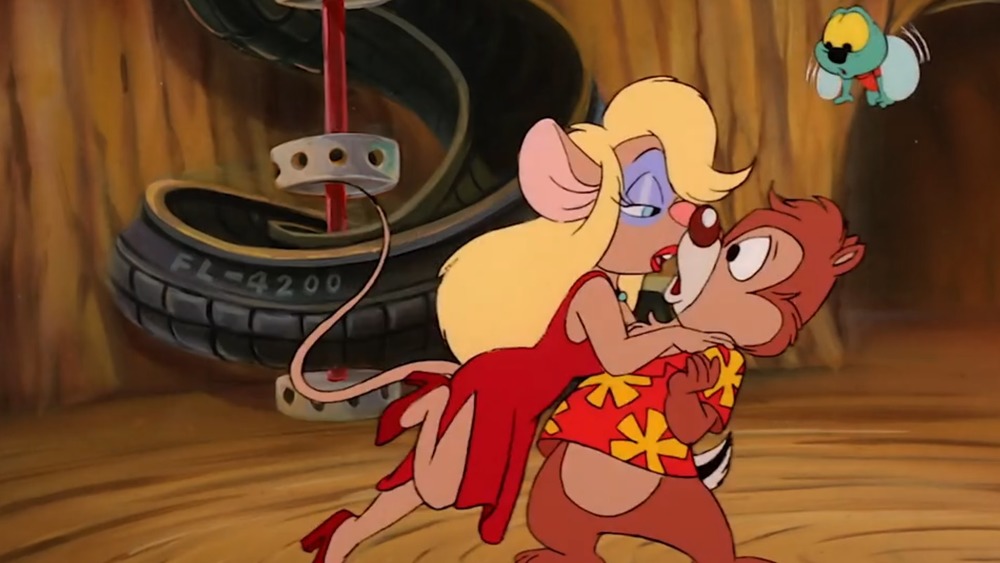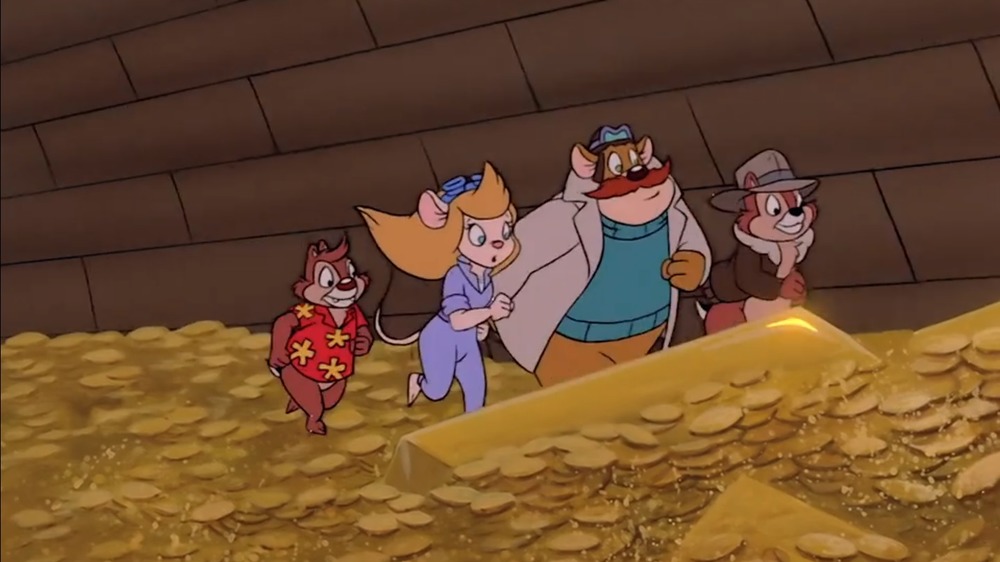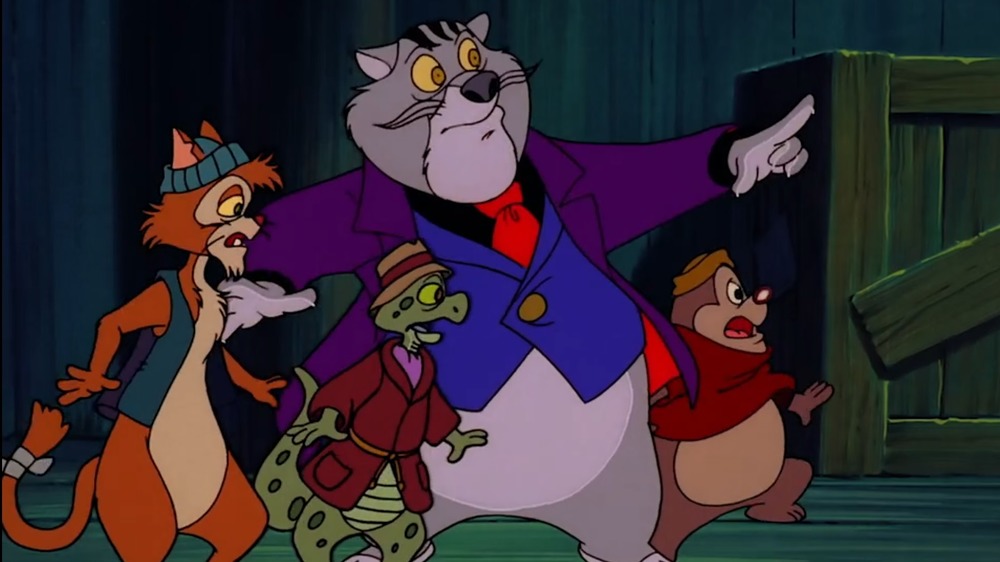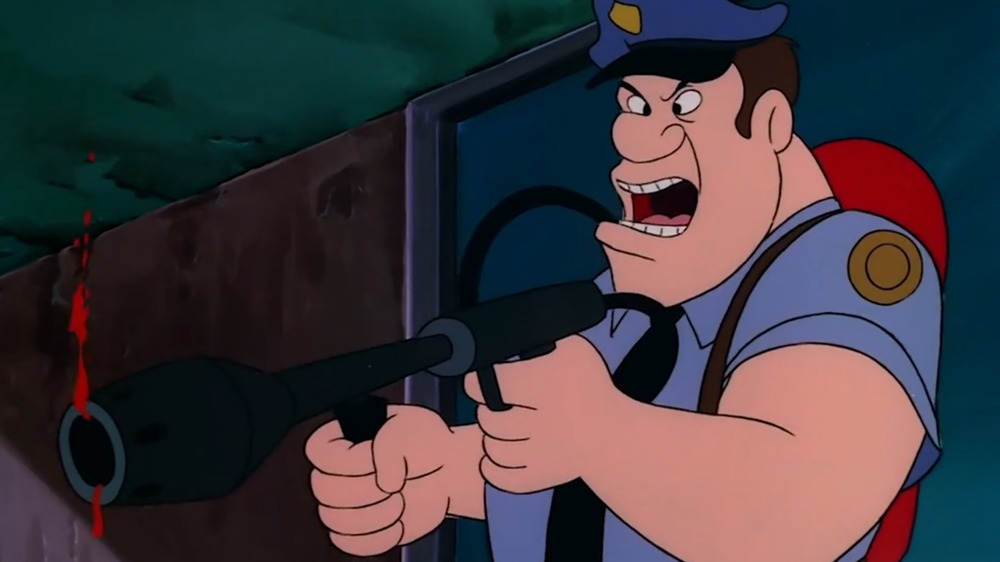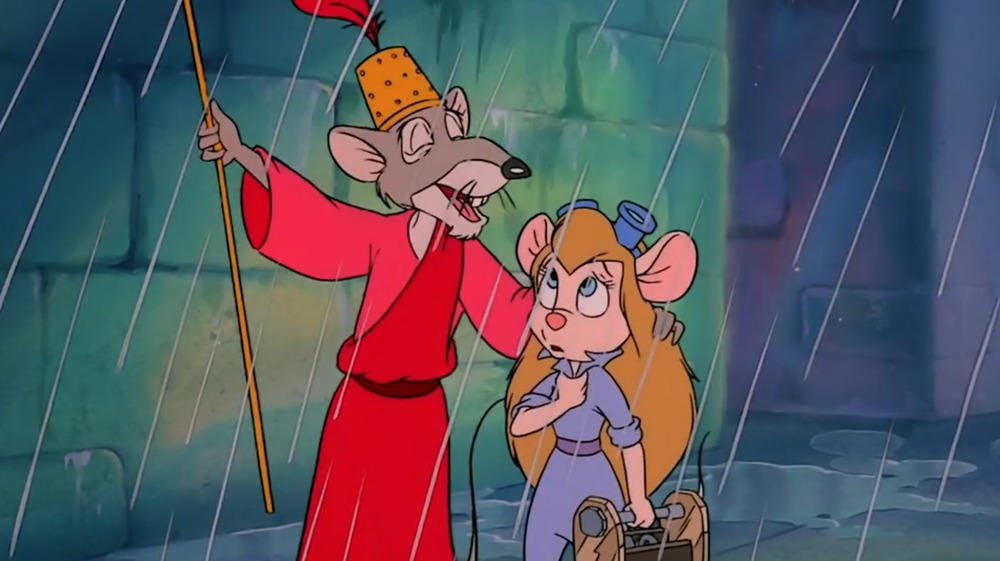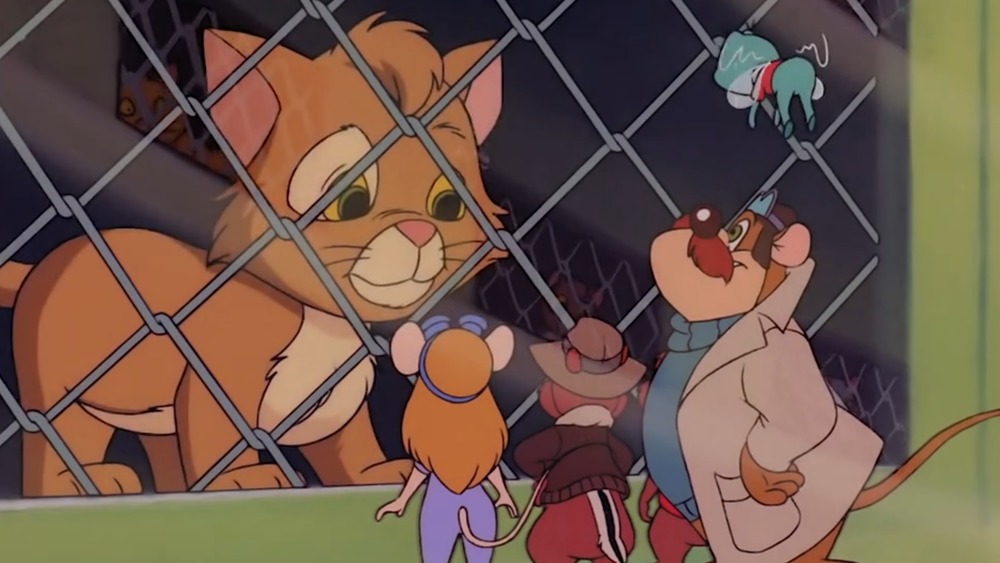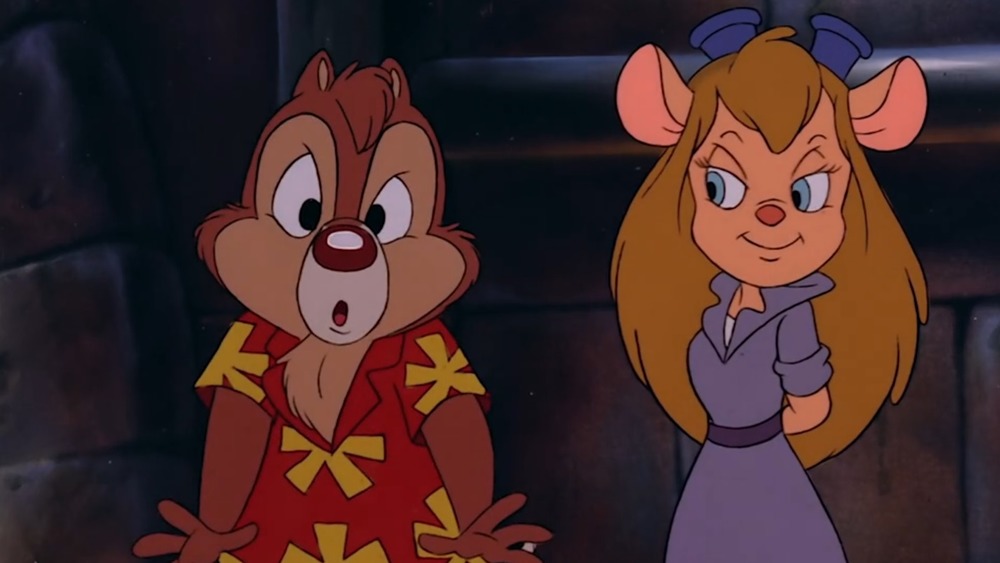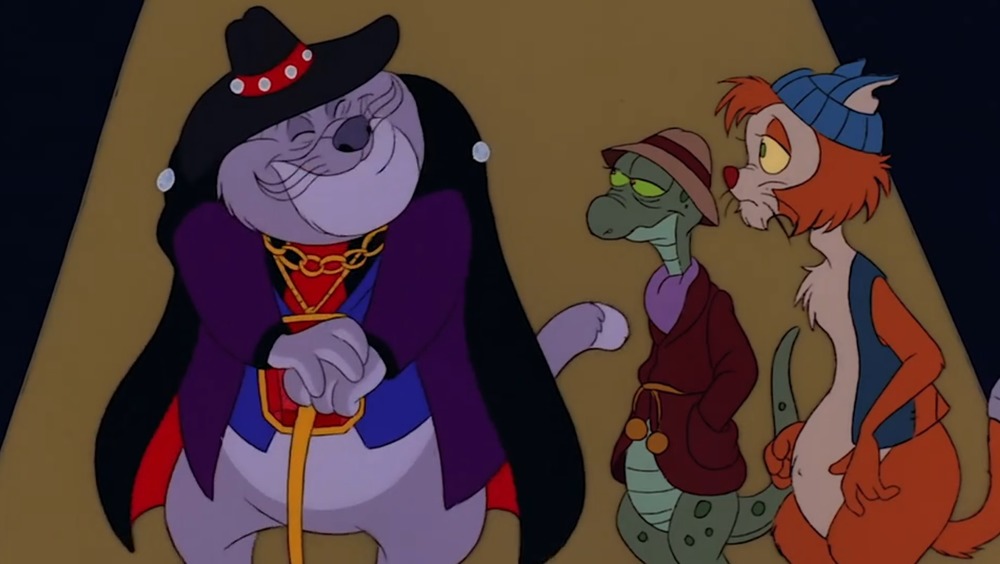Things Only Adults Notice In Chip 'N Dale Rescue Rangers
Chip and Dale were pals long before they became gumshoes. The two adorable chipmunks were introduced in Disney theatrical shorts, debuting in 1943's Private Pluto as anonymous troublemakers. They wouldn't be given proper names for another four years, when the rodents began to tangle with Donald Duck. The two would become beloved characters for the company over the years, but many fans got to truly know them through the reimagined version that helped flesh out the duo and give them more purpose than mischief.
Chip 'n Dale: Rescue Rangers premiered in 1989 and ran for three seasons, consisting of a total 65 episodes. The series was exciting and clever with solid animation and a list of voice actors that are now considered some of the best to have ever graced the business. Rescue Rangers has lived on in syndication, spawning a slew of merchandise from comics and video games to a set of McDonald's toys.
For years, fans had a tough time tracking down the whole show, as they were never fully released on VHS and the DVD sets only encompassed the first 51 episodes. But it now lives on the Disney+ streaming service and can be viewed in its entirety, allowing original fans of the series to relive it with their own children. With that in mind, here's a look at things only adults notice in Chip 'n Dale Rescue Rangers.
Influences big and small
Longtime fans of the show are familiar with the classic entertainment that helped shape the Rescue Rangers. For the two main characters, it's in their attire. Chip sports a bomber jacket and fedora to resemble the iconic Indiana Jones, while Dale has an Aloha shirt to channel the protagonist of the hit Magnum P.I. Monterey Jack's primary influence is obvious, Crocodile Dundee, while Gadget seems inspired by Jordan from Real Genius. Some also claim that their little buddy Zipper is meant to be like Rin Tin Tin, the German Shepherd movie star, rounding out a strong cast of archetypes.
The adventures themselves pull from many different sources and usually see the group tackling small problems like lost pets and theft but go all the way up to framed police officers, kidnappings, and city-wide destruction. The group getting involved with so many human affairs resembles The Rescuers and its sequel, a set of characters that were originally suggested as the stars when the show was first pitched. Their origin episodes even have the team assisting Donald Drake and Plato, referencing the original Chip n' Dale shorts where the duo dealt with Donald Duck and Pluto. There is also a heavy Sherlock Holmes vibe, going as far as to introduce Sureluck Jones in the episode "Pound of the Baskervilles."
Rescue Rangers has several other nods. An entire scene in the third episode of season one pays tribute to Alien with a creature that has three nested mouths, the last of which bites the nose of a Ripley-like stand-in. There are also several minor character names that represent real-world figures, like Stan Blather for Dan Rather, Sugar Ray Lizard instead of Leonard, and Arnold Mousenegger to name a few. The funniest one is a Mr. Wizard knockoff show, including a gag about kids wanting to learn to make plastic explosives out of household detergents.
Small love
Gadget Hackwrench is a well-meaning genius inventor whose creations don't always work as intended, but Chip and Dale sure think she's a dream girl. Some of that may have carried over to those who watched the show growing up — it isn't hard to find fans who say she was one of their early crushes. This created a competition between Chip and Dale for Gadget's affections, always one step away from becoming a full-fledged love triangle, but cuter. There is some mild flirting going back to the show's second episode, and a little light kissing, mostly on the cheek. Gadget smooches both of the boys in various episodes, while they sometimes receive those same affections from other guest characters. Monty also gets a kiss from a pseudo-femme fatale in a later adventure, while Zipper tries to date out of his league when he falls for a queen bee in the show's ninth episode.
Even animals do stupid things for love. Dale fakes breaking his toe to receive Gadget's affections in the sixth episode and Monterey Jack defends those actions, saying, "I wouldn't mind breaking me own head if I had a nurse like Gadget waitin' on me." The episode "Adventures in Squirrelsitting" even sees Tammy develop a crush on Chip. Not only calling him "Chipper" as a pet name, but she decides to prove herself to him after an argument by sneaking into Fat Cat's hideout, putting herself in danger. There isn't a ton of blatant romance, but there are a lot of small things to look out for between the characters. It's funny to watch the boys get upset over a new mouse that has Gadget's attention during the 18th episode, but there are also smaller familial relationships, like when Gadget discusses losing family or when Monterey must deal with his father not being a good fit for the team in episode 13.
Animal magnetism
This isn't the type of show where one looks for sexual themes, but the show has a few moments that seem odd. The main characters are almost always wearing their standard uniforms, but for the males, those don't involve pants. There's even a Robot Chicken sketch poking fun at this, where Gadget ditches the pants for clothing equality. Some characters switch up their attires for special occasions, wearing spandex, swimsuits, or nothing at all, but these are mostly innocent.
The big scene for many is in "Double-Oh Chipmunk," when Gadget dons a sultry red dress that drives Dale wild and is later used to seduce one of the goons with a glance and a little shoulder. The guys get in on this too, often cross-dressing for disguises. Chip and Zipper do it some, but Dale is forced to perform the most, often with a wig and accent. The two titular characters have to dance for Fat Cat like this, a clip of which is in the show's intro.
The most exposed skin and cleavage come from the actual humans, but they never stay onscreen long. There are a few quick shots of underwear, usually played for laughs with characters like Winifred in episode 39. In episode 16, the group tries to help a man who winds up naked, and Monterey Jack makes a joke about him being caught with his pants down. The animation is never inappropriate or too suggestive. There isn't even a need to show the person, as some kids may not have grasped the implied joke when the cops are looking for Zipper in episode 11 and burst in on a woman changing clothes, only showing the officers' reactions.
Tiny capitalism
What would chipmunks, mice, and a fly need with money, considering that most of the group's vehicles and lodgings are made from discarded items? When presented with financial reward or stolen treasure, they still discuss all of the cheese or comic books they could buy, so it looks more like a case of a capitalistic upbringing. Though the Rangers never ask for payment, their cases often present opportunities to acquire riches as well as hidden wealth, even if it's just food.
The heroes often risk their freedom for a chance at treasure and even keep secrets from others to not split the bounty, as seen during the Pi-rats episodes. Dale is the worst of them, not wanting to give up a valuable ring in episode 15, even after seeing it was cursed and an immediate danger. Unsurprisingly, many of the human characters are seen executing elaborate schemes to make money, but failing due to greed.
Monterey Jack's gluttonous self-indulgence for cheese is treated as an addiction, but food is noted as a currency, like when Fat Cat is seen paying other cats with a suitcase of fish in season two. Monterey's cheese obsession is so bad, it causes him to botch rescuing Gadget at one point in episode 36. In the episode "A Lad in the Lamp," he finds a genie and his greed ostracizes him from his friends, almost costing the rodent his eternity. His wish for more cheese than anyone could eat overflows the Rangers' headquarters, but Monterey insists he wants even more. The worst part is that Jack doesn't realize how bad his problem is and often deflects. He points out an alien character's lack of control with food in episode 3 and Dale's obsession when consuming chocolate in episode 28, both while ignoring his shortcomings.
The cat problem
Something kids may not quite grasp while watching the show is the very terrifying and real fear a mouse or other small creature might have of a cat. Rescue Rangers poses its feline characters as the main antagonists, minus a few special occasions and the exception of kittens. If the program is to be believed, as soon as that cat grows up, it's a menace. Monterey Jack is particularly against these vile creatures, even stating firmly that there is no such thing as a "nice cat." He does come around on them a bit, learning that even cats have their place, but it isn't reinforced.
Fat Cat, Maltese de Sade, the Siamese Twins, and Kismet all make life tougher for the Rangers, but the question of nature versus nurture does come into play, as Fat Cat and the others fear and hate dogs, showing signs of a vicious ecosystem. In one particular case, a robot cat named Tom starts off as friendly toward everyone until Fat Cat changes the video game that acts as his programming to something violent, altering his personality and making him a terror. This incident in the episode "Robocat" almost proves Monterey's point about the feline fiends, but thankfully the crew figures out that it was the influence of their arch-nemesis that caused the real issue.
Reduced violence
The animal world in Rescue Rangers is quite violent — they always seem to be trying to eat or kill each other, and a lot of critters in this show are trying to commit hard crimes. These activities result in conflicts that see the beasts trying to throw each other off ledges, putting them in wood chippers, or blowing the innocent up with fake volcanos. Many episodes show cartoonish acts of brutality, mostly large scraps inside dust clouds and villains being tricked into hurting themselves or being slung around by their tails. Not everyone is bloodthirsty, as we see the two main characters constantly trying to pummel each other in some sibling rivalry. In "Dirty Rotten Diapers," Gadget tries to get the team to adopt a non-violent approach for conflict, but winds up going more berserk than everyone else.
Rescue Rangers features a large number of firearms, but most of them are wielded by ineffective people. Human crooks and cops often brandish their guns and fire wildly, missing or doing something comical. If people do get hit, it never does damage. When Dale gains super-stretching powers and becomes a costumed hero in episode 34, bullets push into him, but bounce back. The non-humans use smaller weapons, sometimes in the form of pop-guns or crafted launchers to go along with their makeshift blades. Realistic guns do make it to the animal world in the episode "Puffed Rangers," in which automobiles are being shrunk down to be smuggled. Some of the "toy" firearms the Rangers encounter seem to be shrunken real ones and are still fully functional, meaning audiences get to see Gadget wield a proper bazooka and blow a door open.
Religion and the beast
Belief of a spiritual nature or extraordinary forces exists in Rescue Rangers, even if it seems to be on the fringe of such concepts from a human perspective. In the episode "Kiwi's Big Adventure," the Ranger Plane crashes and a tribe of birds adopts it as their god, believing it will grant them the ability to fly again. There is also an example of the feared god with Ribbit, a frog worshipped by a group of water beetles that believe they must do this or risk being eaten, so they make Zipper their king and sacrificial snack. Gadget also joins a cola cult that has built a religion around a catchy soda ad in episode 14.
We see individuals putting their decisions and lives in the hands of outside forces, like one man who's obsessed with superstition and fate in episode 7, when it was his good luck animal causing all of the problems. The Rescue Rangers' world is different, as it is one where demons can be awakened, ghosts exist, genies grant wishes, and magic is real, but most of these things are tied back to the individual believing in something. In "Good Times, Bat Times," a former cleaning woman named Winifred learned her magic from reading in the library and has three animal familiars.
Protect the Little Children
In many cases, the Rangers wind up dealing with human and animal children, protecting babies from being harmed or helping return them home. The group tries not to help them in a couple of cases, but they're just seen as too cute to ignore. No matter how much the heroes try to keep these kids out of harm's way, it's bound to happen and conflict emerges. Fat Cat is often seen threatening these kids and the adult fear of losing a child this way comes out in an episode like "Three Men and a Booby," which may resonate less with younger viewers.
Human babies are a little tougher to manage, since the parents can't understand the animals. "Bearing Up Baby" sees Humphrey, a bear, trying to return a child to the family, but scaring them instead. Gadget has to try and explain how the humans must feel seeing him with their offspring, afraid that he'd hurt the infant. The show does the opposite of this, though, in episode 38, when it turns out a "baby" is the ringleader of a complex burglary ring ran out of an adoption agency.
Self-doubt and delusions
Often, the Rangers are their own worst enemies. Moments of self-doubt and delusional thought become focal points for plots, but sometimes it isn't clear how much these things affect the individual characters. The obvious one is jealousy, seen when Chip and Dale are afraid a lab rat named Sparky is getting all of Gadget's attention and it begins to affect their work in episode 18. This happens a lot more on smaller scales throughout the series. Monterey Jack has to deal with being a coward when what he believes to be a ghost cat threatens the crown jewels in episode 9, which almost causes him to lose his friends. Zipper is tired of being scrawny and not as big or strong as the others — even if he seems powerful for a fly — resulting in a zany adventure when he grows bigger in episode 11, after being hit by an enlarging ray. Gadget has the most trouble with losing faith in her own inventions, finding them not to be effective in episode 14. This is a recurring thing, coming up again for side plots, comedy, or Monterey Jack flinching when she asks him to test something.
We also have characters that are incredibly superstitious and delusional. The crew believes Chip is actually going to die after a warning from a fortune-telling moth in episode 22, while several of the heroes believe in magic carpets, even after seeing the circuitry in them. Monterey also seems the quickest to believe that a case involves genies and wizards until the truth is revealed in episode 11, which makes more sense when he later encounters a real genie. Dale is a bit dumb and not always in sync with reality. He seems to think that many things on the television are real and finds comic books to be good sources of information.
Language and other diminutive words
Words have meaning, but it's easy to slip things in under the guise of cultural sayings, accents, and playful language when the characters are cute animals. Still, some of these phrases are not going to register for younger kids — or may even teach them words incorrectly. Though colorful, Fat Cat is constantly insulting his own minions, saying stuff like "I bet mind-readers only charge you half price," and he refers to one of the chipmunks as a "diminutive nut-muncher." Monterey, being from Australia, refers to some female characters as Shelias and calls several minor characters 'blighters.'
There are some words that kids will just have trouble understanding, like when the genie refers to the Caliph in episode 6, or that the man obsessed with good fortune in season 2, episode 7 named his cat Kismet, which means luck or fate. It's in the episode titles too — phrases or references that children wouldn't know, like "Battle of the Bulge" or "Does Pavlov Ring a Bell."
There are also some slightly uncomfortable racial stereotypes that are used, like for the Asian cats in the second episode of season 2 and the Jamaican fruit bats that are introduced primarily by their accents six episodes later. Fat Cat says "That's the problem with foreign imports, it's a pain getting decent service," when displeased with the bats' progress. Taking it that step further, the pandas on loan from China in the zoo during season 2, episode 10 have Asian accents and are, not shockingly, engineering students, getting to go back home because they "contract" a fake disease called Panda Pox.
